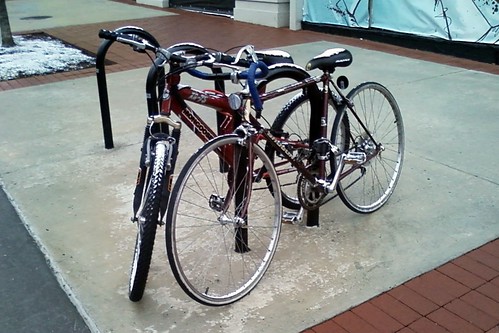Another novelty is the duplex wheel [that is, bicycle - with side-by-side seating], with the Maxim rapid-firing gun mounted upon it. It carries two riders, one to propel the machine and the other to work the gun. It is understood that a proposition has been made to the representatives of the Cuban government to equip a regiment of their soldiers with these machines, it being shown that with proper handling they would prove awful and effective engines of destruction.Unfortunately no illustration of this bicycle was included and I have had no luck finding one elsewhere. The machine-gun equipped bike didn't seem to prosper as a tool of war.
When the first diamond frame bicycles became popular in the 1890s they were often called "wheels" - the national cycling association was called the "League of American Wheelmen." We have moved from "wheels" to "bikes," but the bicycles have remained remarkably the same over more than 100 years - elegant in their efficiency and simplicity. And many of the issues that we think are new? They were around then too.
Thursday, March 31, 2011
Maxim Gun Equipped Bicycles (1896)
Part of an article about a bicycle show in Washington DC - the article is in the Washington D.C. "Morning Times, March 26, 1896 issue.
Monday, March 28, 2011
The Woman Cyclist - 1896 Article
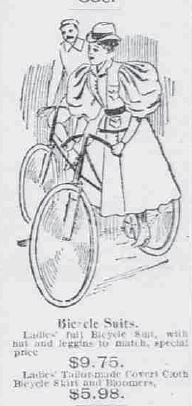
Ad for "bicycle suit" for women cyclists, 1896
Text from an article in the Washington DC Morning Times, June 7, 1896.
THE WOMAN CYCLIST.And finally this ~
She Reigns Supreme This Season. Some Timely Suggestions for Her.
The woman cyclist reigns this season. The number of women who have taken to the wheel shows an increase of 75 percent, and the makers of machines for women can scarcely keep pace with their orders.
In the selection of a machine most women who are making their debut as riders this reason need reliable wholesome advice, and if any points of value are secured from this article its purpose will have been fulfilled.
So far as the costume is concerned, knickers are very largely worn in Europe, especially in Paris, but in America they are the exception more than the rule, and therefore this is addressed to ladies who will ride in skirts.
The question of weight in connection with ladies' machines has recently received more attention at the hands of manufacturers than ever before, and the consequence is reliable machines may now be purchased, fitted with brake, mud guards, dress-guard, and gear-case at just about thirty pounds in weight.
In selecting a machine a lady should see that the handle bars and saddle can be so adjusted as to enable her to sit perfectly upright, for nothing looks much worse than to see a lady adopting what is known as the "scorcher" attitude.
Large makers build machines in more than one size, and exceptionally short and exceptionally tall ladies should have machines built higher and lower respectively in the frames than standard patterns.
The pedals should be rubber, and not all steel, the latter with their sharp points being more liable to catch in the rider's dress, pedals to suit the width of foot, can, of course, be selected.
A really first class-machine by a leading firm will cost nearly $lOO, or perhaps a little more, but, of course, very good machines can be purchased for less than that amount.
There are several little things a tider should be particularly careful about, and one of these is the application of the brake. The brakes fitted are usually those which act on the tire, and should consequently not be too suddenly applied, or they will probably tear the tire.
A lady will find it very convenient to mount from the curb, and will thus be enabled to properly arrange her dress. Sometimes this method of mounting is impossible. A lady will then do well to allow one of the pedals to ascend to its fullest height and descend the merest trifle, and then, placing one foot on the pedal in question, spring into the saddle, the weight of her body on the pedal necessarily causing the machine to go forward. When well going it will only be necessary to slightly raise herself in the saddle, actually standing on the pedals, and the dress will fall as it should. This will be found to be a perfectly easy accomplishment with a little practice.Full article as PDF is here.
Sunday, March 27, 2011
Bikes that Live Outside & Snow
Saturday, March 26, 2011
Cross Country Cycle Road - 1896 Plan

Map for a cross country bicycle route
Taken from Washington DC Morning Times, June 7, 1896. Reflects some wishful thinking on the future of cycling in the days before automobile owners (and their allies) took over the lead in advocating for funding a good network of roads. The article's author advocates a connected network of "good roads" rather than more expensive macadamized (asphalt) dedicated "bicycle tracks" or "bicycle paths" for long distance bicycle travel.
Some quotes ~
To establish a bicycle track from coast to coast so that wheelmen can journey from New York to San Francisco as easily if not as rapidly as they now do by train. Such tours have been undertaken and partlv carried out. One man would wheel from Salt Lake Cit to Buffalo. Another, at some time, would start at Chicago and wheel to the Pacific Coast. But they seldom wanted to take the trip twice. It was too tiresome. Roads were too bad. Too many mountain paths had to be climbed, too many prairies tortured through. But I am looking into the matter so as to do away with all this.
What has hampered us more than anything in this cross country project are the wheeling [cycling] enthusiasts. These gentlemen insist upon bicycle paths and so we get nothing. A macadamized bicycle path costs in a rocky locality $15,000 per mile. Now make this same locality and use tho road that is already in it by merely improving it and the cost will not be $3,000. You can make a mile or very bad road into very good road for that sum. That is what I mean by intelligent wheeling legislation.
"Across the country in eighty days will be the wheelman's attraction a few years hence. Now it looks funny, but that is what Jules Verne's idea or "Round the World In Eighty Days" did to people years ago. Now we can belt the sphere in seventy days."Full text of article available most readably here.
Saturday, March 19, 2011
108 Links, Half Inch of Stretch (Full Link)
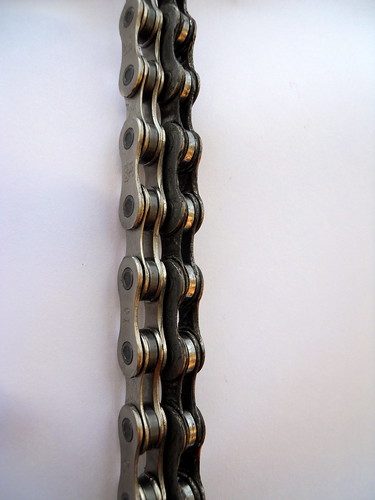
New chain and old chain match up for while, more or less
On the left is a new SRAM chain for my Traitor Ruben, on the right is the original SRAM chain after (?) 3,000 miles (I guess). Turns out the original chain is the 1030model, which is the least expensive 10 speed chain they have (and stretches the fastest, it seems). Since my "good" road bike has a Shimano CN-6600 10 speed chain that hasn't stretched yet, after more like 5,000 miles, I was quite surprised to realize (a) that this was a cheap chain, and (b) that it has stretched a lot.

Over the full length of the chain, full link worth of stretch
The chain has 108 links (one half inch per link, when installed - total of 54 inches) plus a "power link" to hook the ends together. After however many miles I have gone, the chain is now one full link (one half inch) longer overall. Should have replaced it a while ago! To slow down this problem, I bought a better grade of SRAM ten speed chain to replace it.
It isn't the chain plates that stretch, of course, but the pins inside that bend. I don't think this caused the cogs or rings significant damage. Hmm . . .
Small Things Can Be Problems
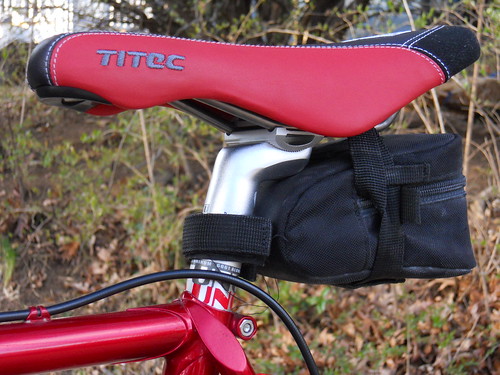
Troublesome underseat toolbag
Over time it becomes clear that even small purchases of items that should be straightforward can be problematic. There are various choices for underseat toolbags, but they are all basically the same idea - carry an extra tube, a multitool, perhaps a flat kit as well and I also have a couple of my favorite Allen wrenches.
While the bag shown above looks fine, after I used a wrench in it last, in closing it the zipper came off. Once I open it again (it is presently stuck closed) that's the end of that. A previous bag with an Allen wrench got a hole where apparently the wrench constantly rubbed - I found the wrench attempting to escape before it got away, fortunately. Buying toolbags is getting habit forming!
A possible solution I suppose is to buy a leather Brooks Saddles Challenge Tool Bag for ~$90 or so. No, that isn't going to happen. Hmm. . .
Friday, March 18, 2011
Detour Closed; Bike Trail Restored
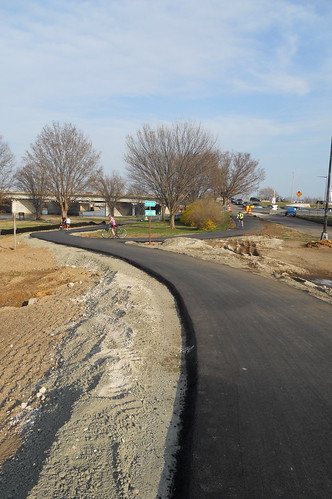
The newly restored bike trail, from the new approach to the Humpback bridge
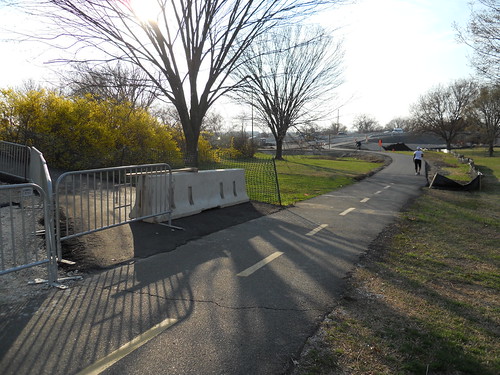
Detour is closed, new routing (much like the old) is restored with new asphalt
The new asphalt already continues across the new bike portion of the Humpback bridge.
I didn't take anyone's photo, but an amazing number of people ignored the open trail in front of them and slowed to turn up the detour and couldn't figure out that all they had to do was . . . continue up the open trail in front of them. Habit forms quickly, I guess.
Subscribe to:
Posts (Atom)
